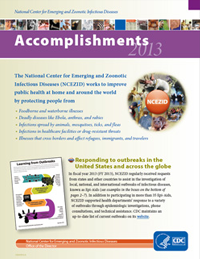NCEZID Accomplishments 2013
Improving Public Health:
- Protecting public water systems and the public from Naegleria fowleri (brain-eating ameba) infections
- Eliminating healthcare-associated infections (HAIs)
- Sounding the alarm about the threat of antibiotic resistance
- Containing a deadly and unprecedented outbreak of fungal meningitis
- Revealing which foods cause foodborne illness
- Innovating solutions for sanitation in Kenya
- Improving refugee health
- Tracing a new virus to ticks
- Laying a new pipeline to rapidly identify infectious disease
- Identifying a new poxvirus
- Speeding up laboratory reporting
Responding to outbreaks:
- Michigan — CDC responded to an outbreak of Clostridium difficile (called C. difficile) infections
- Colorado — Outbreak of the deadly superbug CRE
- US (multistate) — Human rabies transmitted during organ transplantation
- US (multistate) — Listeria infections associated with contaminated cheese
- Uganda — Ebola hemorrhagic fever infection
Responding to global outbreaks:
- Puerto Rico, multiple countries worldwide — One of the largest ever outbreaks of dengue virus infections
- US and Mexico
What’s ahead for NCEZID in 2014:
